“Endangered!”
New Paintings and Original Prints by Mary McGrath
Opening Words by Éanna Ní Lamhna on Saturday 30th September 2023.
The exhibition continues until 21st October, 2023.
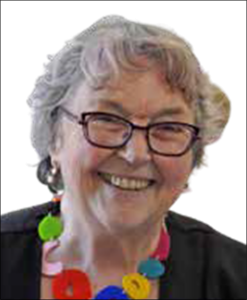
“Endangered!”
New Paintings and Original Prints by Mary McGrath
Opening Words by Éanna Ní Lamhna on Saturday 30th September 2023.
The exhibition continues until 21st October, 2023.

ART PRACTICE
2017 Exhibited with Leinster Print Studio, Co. Kildare. Exhibiting in France, Spain, England, Bulgaria, Ireland. Finland
2019 – 2023 Group exhibitions in Kilcock Art Gallery:
Member of SULT Artists Collective – Gallery 8 Kildare: Phoenix Park Visitors Centre Dublin & Newbridge Co. Kildare.: Bolands of Kildare: Gra Gallery, Naas :”The Artists Well” in conversation with Alan Keane
2023 Solo Exhibition in Kilcock Art Gallery, Co. Kildare, Ireland. entitled: “Endangered!” on Biodiversity
“Endangered!” Solo Exhibition 30th Sept. – 21st Oct. 2023.
“My artwork invites the viewer to be aware of their surroundings. To give nature a chance to recover. To appreciate and cherish our ecosystem’s survivors and realise that we can all make a positive difference.”
Mary McGrath’s career in art spanned the USA, London & Dublin. She studied History of Art in Trinity College Dublin then Conservation of Paintings at the Courtauld Institute, London University followed by a Fellowship to Harvard University. She then worked as Paintings Conservator at the RMRCC in Denver. Following the presentation of a paper at a gilding conference in Philadelphia Mary was invited by the Getty Museum, Los Angeles to be a visiting consultant for two consecutive summers.
In Ireland, Mary McGrath worked in the Hugh Lane Municipal Gallery, Dublin as Paintings Conservator for many years and also worked on contract for the National Gallery, The National Museum and the Irish Museum of Modern Art.
One of the most interesting projects she managed was moving Francis Bacon’s studio from London to Dublin. This involved innovative techniques where archaeologists formed a vital part of the team. Subsequently, she presented papers documenting the move at museums in the United States, England, Spain and Ireland.
“Conservation of Art & Nature have been two constant inspirations during my career. This exhibition is my effort to raise awareness and start a conversation.
Horses, Rare Breeds, & Biodiversity are the subject matter of my paintings and drawings. Working in oils, print and watercolours my aim is to depict the variety and variability of Irish wildlife and the richness of our native animals and birds which have survived despite intensive farming, habitat destruction and the demands of industry.
While my art conservation career took me to cities around the world, my roots called me home to Kildare in Ireland where I developed a keen interest in native breeds and biodiversity. This also inspired me to write and publish two books: The Irish Draught Horse and The Kerry Bog Pony. Now, as I indulge my love of painting, my passion for biodiversity and conservation of our natural world continues to imbue my work.
Spending time on my smallholding during lockdown reminded me of what we have already lost, many hares and skylarks, bees, and ladybirds. The curlew has long since gone. But there is always hope. My art is an attempt to highlight nature’s beauty, the importance of retaining and encouraging wildlife habitats and what can be lost if we don’t.
Mary McGrath September 2023
An OAK Sapling will be planted for every Artwork sold in this Exhibition.
SELECTED WORK AS Consultant Conservator: Irish Museum of Modern Art IMMA: OPW: Hugh Lane Gallery: Iveagh House, Irish Stock Exchange: Leinster House: Russborough House: Trinity College: USA Embassy: St Kevin’s Harrington Street: RHA, Davy Stockbrokers: Carton House: Tallaght Hospital: Visual, IMMA – (Coleman, Freud, Sean Scully, Tim Robinson): Fonsie Mealy: DeVere’s Art Auctions: Royal Hibernian Academy: St Bartholmew’s Ballsbridge: City Hall (Patricia Wrafter Conservation Architect),: Aras an Uachtarain: A&L Goodbody: Crawford Gallery: Price Waterhouse: St Muiredeach’s Cathedral Ballina : Dublin Stock Exchange(David Slattery Conservation Architects), Trinity College Dublin, Exam Hall, (John O’Connell, Conservation Architect): Kilmainham Gaol (OPW Gretta Doyle Architect): 14 Henrietta Street (Dublin Corporation): 15 –17 Moore Street (Grainne Shaffrey Architect): National Gallery of Ireland (Blackwood and Associates Architects): Alexandra College: Kilmainham Courthouse (OPW Gretta Doyle Architect): Moore Street, (Grainne Shaffrey Associates Architects): St Kevin’s Harrington Street, (Bluett & O’Donohue Architects): Belvedere House, (David Slattery Architects): OPW: UCC: Arts Council: Mansion House: Marlay House: St Mary’s Cathedral Kilkenny, (Bluett & O’Donohue Architects): National Gallery (Blackwood and Associates Architects): Dublin Castle (Architect John Cahill): Arts Council: UCC,(Architect John O’Connell: Bishop’s Palace Waterford : ESB: St Mary’s Cathedral Kilkenny: Bishop’s Palace Waterford: Wexford County Council: RTE: Leinster House (Murray O’Laoghaire Architects): A&L Goodbody: McCann Fitzgerald: King’s Inns: Louis le Brocquy; Catholic Cathedral Waterford (Architect: Ron Falconer): Denver Museum of Art, Colorado: The Landmark Trust, (Shaffrey Associates – Architects); plus, many private clients 2002 Presented paper on Bacon Project Innovations at AIC Conference in Houston Texas. Lecture Tour: Getty Museum, Los Angeles; Museum of Modern Art, San Francisco; Denver Art Museum, Colorado. Museo Nacional Centro de Arte Reina Sofia, Madrid. Victoria and Albert Museum, London; Private group Orange County, California; Private group Harvard University, Massachusetts 1998-2001 Conservator in charge of deconstruction, packing and moving Francis Bacon’s Studio & contents from London to Dublin for Hugh Lane Gallery, reconstructing studio and replacing contents. (David Chipperfield Architects, London) Part-time lecturer Trinity College- History of Art: I.P.A.V: Francis Bacon Studio Project, Hugh Lane Gallery, Consultant Conservator: Hugh Lane Municipal Gallery of Modern Art, Dublin, Project Manager: Organised team to prepare and pack 100 paintings from the Hugh Lane for travel to Japan – personally supervised hanging and installation in Hokkaido, Japan John Paul Getty Museum, Malibu, California. Visiting Consultant, Philadelphia, USA . International Gilding Conference. Presented Paper on Trinity Frame Rocky Mountain Regional Conservation Center, Denver, Colorado. Consultant. Paintings Conservator for National Trust, Northern Ireland.
Corncrake Watercolour on Paper 42X30cms
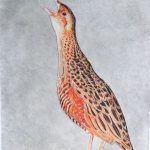 In the 1960s and 1970s the distinctive call of the corncrake was the sound of the summer. However due to changes in farming practices – higher stocking levels and the changeover from hay to silage, these ground nesting birds were severely impacted, leaving only 120 calling males mostly in the northwest and off shore islands. Over the past five years due to collaborative conservation measures involving local farmers and communities, the Corncrake LIFE Project, and the NPWS there has been a 35% increase in the corncrake population although the overall numbers remain very small.
In the 1960s and 1970s the distinctive call of the corncrake was the sound of the summer. However due to changes in farming practices – higher stocking levels and the changeover from hay to silage, these ground nesting birds were severely impacted, leaving only 120 calling males mostly in the northwest and off shore islands. Over the past five years due to collaborative conservation measures involving local farmers and communities, the Corncrake LIFE Project, and the NPWS there has been a 35% increase in the corncrake population although the overall numbers remain very small.

Tern Oil on Canvas 25X30cms
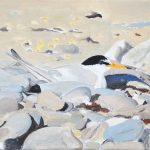 Summer visitor from March to October. Breeds on the coast, with larger colonies in Co. Dublin, Co. Wexford and Co. Galway. This year BirdWatch Ireland staff have been dealing with unprecedented outbreaks of bird ‘flu at some of Ireland’s most important tern colonies. There are fears for the long-term devastating consequences this outbreak may have on Ireland’s seabird populations, which are of international importance.
Summer visitor from March to October. Breeds on the coast, with larger colonies in Co. Dublin, Co. Wexford and Co. Galway. This year BirdWatch Ireland staff have been dealing with unprecedented outbreaks of bird ‘flu at some of Ireland’s most important tern colonies. There are fears for the long-term devastating consequences this outbreak may have on Ireland’s seabird populations, which are of international importance.
Lapwing Watercolour 36x30cms
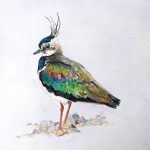 Ireland’s National Bird. Like many other ground-nesting birds, the lapwing has suffered major declines over the last forty years due to the loss of wetland habitat and changes in farming practices. The bird is now red-listed on the Birds of Conservation Concern in Ireland and is a Northern Ireland priority species because of its decline, rarity and importance. This year thanks to conservation efforts two pairs of Lapwing nested successfully in Co Down after a gap of many years.
Ireland’s National Bird. Like many other ground-nesting birds, the lapwing has suffered major declines over the last forty years due to the loss of wetland habitat and changes in farming practices. The bird is now red-listed on the Birds of Conservation Concern in Ireland and is a Northern Ireland priority species because of its decline, rarity and importance. This year thanks to conservation efforts two pairs of Lapwing nested successfully in Co Down after a gap of many years.
The Freshwater Pearl Mussel
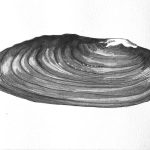 The freshwater pearl mussel which is only found in near-pristine freshwater habitats can live for up to 140 years, making them Ireland’s longest living animal. The tiny Larvae and juvenile mussels need a clean, well oxygenated river bed in order to survive. They also rely on a host fish for part of their complex life cycle. Increased intensification of land use has contributed to poor water quality. The low level of survival is leading to an ageing population not capable of replenishing itself. European freshwater pearl mussel populations have declined by 90% over the past century. In Ireland, 27 freshwater pearl mussel populations are protected within Special Areas of Conservation (SACs) but these populations are also undergoing a slow decline, and face extinction unless action is taken.
The freshwater pearl mussel which is only found in near-pristine freshwater habitats can live for up to 140 years, making them Ireland’s longest living animal. The tiny Larvae and juvenile mussels need a clean, well oxygenated river bed in order to survive. They also rely on a host fish for part of their complex life cycle. Increased intensification of land use has contributed to poor water quality. The low level of survival is leading to an ageing population not capable of replenishing itself. European freshwater pearl mussel populations have declined by 90% over the past century. In Ireland, 27 freshwater pearl mussel populations are protected within Special Areas of Conservation (SACs) but these populations are also undergoing a slow decline, and face extinction unless action is taken.
Curlew Oil on Canvas 50X60cms
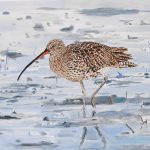 Curlew arrive back at their breeding grounds in late March or early April. They breed on upland and lowland bogs, wet grassland and unimproved/semi-improved pasture. Curlew numbers have declined drastically from 5000 nesting pairs in the late 1980s to approximately 130 pairs today. A decline of 97% in just 20 years. This is due to habitat loss and predation. They are critically endangered.
Curlew arrive back at their breeding grounds in late March or early April. They breed on upland and lowland bogs, wet grassland and unimproved/semi-improved pasture. Curlew numbers have declined drastically from 5000 nesting pairs in the late 1980s to approximately 130 pairs today. A decline of 97% in just 20 years. This is due to habitat loss and predation. They are critically endangered.

Irish Hare Oil on Canvas 50X60cms
 Hares will avoid grazing in the same areas as cattle and sheep so any increases in livestock numbers will reduce hare habitats. Populations can vary locally due to direct competition for territory with rabbits and brown hares. Numbers are falling due to habitat loss and predation by foxes, stoats, cats, stray dogs and birds of prey. However the good news is that new populations of Irish Mountain Hares live on the grounds of airports which provide them with suitable habitats.
Hares will avoid grazing in the same areas as cattle and sheep so any increases in livestock numbers will reduce hare habitats. Populations can vary locally due to direct competition for territory with rabbits and brown hares. Numbers are falling due to habitat loss and predation by foxes, stoats, cats, stray dogs and birds of prey. However the good news is that new populations of Irish Mountain Hares live on the grounds of airports which provide them with suitable habitats.
Oystercatchers Oil on Canvas 25X30cms
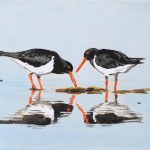 Resident and winter visitor from Iceland and the Faeroes. Their main food is mussels and cockles that are found along sandy coasts. They also occasionally feed for worms on grasslands and football pitches. Nests principally on shingle beaches, dunes, salt marshes and rocky shores around the coast, but also on some large inland lakes. Their numbers have declined about 28% since the early 2000s.
Resident and winter visitor from Iceland and the Faeroes. Their main food is mussels and cockles that are found along sandy coasts. They also occasionally feed for worms on grasslands and football pitches. Nests principally on shingle beaches, dunes, salt marshes and rocky shores around the coast, but also on some large inland lakes. Their numbers have declined about 28% since the early 2000s.
Natterjack Toad Oil on Board 12.7X17.8cms
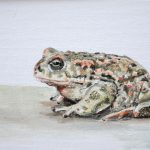 One of Ireland’s most endangered creatures, the natterjack toad, is making a slight comeback. During the recent dry spell many of their local ponds in south Kerry dried up. Spawn was rescued and taken to Fota Wildlife Park where it hatched out successfully. 200 baby toads were then released under a NPWS conservation scheme which compensates farmers who maintain suitable breeding ponds on their land.
One of Ireland’s most endangered creatures, the natterjack toad, is making a slight comeback. During the recent dry spell many of their local ponds in south Kerry dried up. Spawn was rescued and taken to Fota Wildlife Park where it hatched out successfully. 200 baby toads were then released under a NPWS conservation scheme which compensates farmers who maintain suitable breeding ponds on their land.
Puffin Oil on Canvas 60X50cms
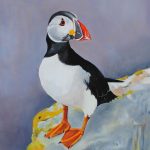 Summer visitor from March to September mainly along the west coast of Ireland but also locally on the east coast and some islands. They live off small fish such as herring, hake and sand eels. They can also “fly” underwater. Using their webbed feet as a rudder, puffins can dive down 60m in search of food. They live for around 20 years. The main threats are overfishing, pollution and climate change which is altering the feeding habitats of their prey species.
Summer visitor from March to September mainly along the west coast of Ireland but also locally on the east coast and some islands. They live off small fish such as herring, hake and sand eels. They can also “fly” underwater. Using their webbed feet as a rudder, puffins can dive down 60m in search of food. They live for around 20 years. The main threats are overfishing, pollution and climate change which is altering the feeding habitats of their prey species.

Pigmy Shrew Oil on Board 12.7X17.8cms
 Is found throughout Ireland. It has a preference for dense habitats such as hedgerows, grasslands, woodlands and peatlands which give protection from predators. The Pigmy Shrew’s heart beats at 1200 times per minute. It eats only insects but because of its high metabolic rate it must eat its own bodyweight every day. The Irish pygmy shrew is now endangered as the Bank Vole and Greater White-toothed Shrew, two invasive species, are taking over their habitat.
Is found throughout Ireland. It has a preference for dense habitats such as hedgerows, grasslands, woodlands and peatlands which give protection from predators. The Pigmy Shrew’s heart beats at 1200 times per minute. It eats only insects but because of its high metabolic rate it must eat its own bodyweight every day. The Irish pygmy shrew is now endangered as the Bank Vole and Greater White-toothed Shrew, two invasive species, are taking over their habitat.
Red Kite Oil on Canvas 60X50cms
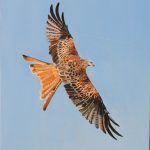 The Red Kite is a very large bird with a wingspan of almost 2 meters. By the early 19th century it had become extinct in Ireland due to overhunting. In 2007 Red Kites were reintroduced to Co Wicklow and later to Fingal, Co. Dublin where they are successfully breeding. As they are primarily scavengers they are under severe threat from poisoning
The Red Kite is a very large bird with a wingspan of almost 2 meters. By the early 19th century it had become extinct in Ireland due to overhunting. In 2007 Red Kites were reintroduced to Co Wicklow and later to Fingal, Co. Dublin where they are successfully breeding. As they are primarily scavengers they are under severe threat from poisoning
Squirrel watercolour 21X29.5cms
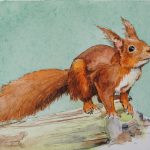 Red squirrels have disappeared in areas where the grey squirrel is common. The recent increase in the numbers of domestic cats and dogs and death by road accidents cause many deaths of red squirrels each year. However the growth in numbers of the Pine Marten has reduced the population of grey squirrels and in some areas of suitable forest habitat the red squirrels are making a comeback.
Red squirrels have disappeared in areas where the grey squirrel is common. The recent increase in the numbers of domestic cats and dogs and death by road accidents cause many deaths of red squirrels each year. However the growth in numbers of the Pine Marten has reduced the population of grey squirrels and in some areas of suitable forest habitat the red squirrels are making a comeback.
Kerry Bog Pony Etching 51X40cms
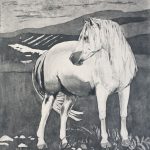 These ponies survived in a small pocket of land in south Kerry where they had been used to take turf in from the bog and to carry seaweed to fertilise the fields. They were identified as a distinct breed in the 1990s due to recent advances in DNA analysis. By this time there were only six stallions and twenty mares known to exist. Urgent conservation measures were taken and today there are around 150 breeding mares with around 60 foals being registered every year. They make wonderful children’s ponies and can also be driven by adults when outgrown by the children.
These ponies survived in a small pocket of land in south Kerry where they had been used to take turf in from the bog and to carry seaweed to fertilise the fields. They were identified as a distinct breed in the 1990s due to recent advances in DNA analysis. By this time there were only six stallions and twenty mares known to exist. Urgent conservation measures were taken and today there are around 150 breeding mares with around 60 foals being registered every year. They make wonderful children’s ponies and can also be driven by adults when outgrown by the children.
Old Irish Goat and Kids Oil on Canvas 50X50cms
 They arrived in Ireland during the Neolithic age, about 5,000 years ago. The Old Irish Goat was Ireland’s only goat breed until around 1900 and was often known as “the poor man’s cow”. The breed could give up to 200 gallons of milk a year. They became extinct in captivity surviving only in feral herds where interbreeding with imported domestic goats caused major loss of the original characteristics. A captive breeding programme is ongoing and the goats are also being used for conservation grazing to create fire breaks on Howth Head.
They arrived in Ireland during the Neolithic age, about 5,000 years ago. The Old Irish Goat was Ireland’s only goat breed until around 1900 and was often known as “the poor man’s cow”. The breed could give up to 200 gallons of milk a year. They became extinct in captivity surviving only in feral herds where interbreeding with imported domestic goats caused major loss of the original characteristics. A captive breeding programme is ongoing and the goats are also being used for conservation grazing to create fire breaks on Howth Head.
Red Deer and Fawn Oil on Canvas 60X50cms
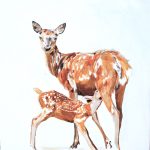 Red deer are the only deer species native to Ireland. They are believed to have been here since the end of the last Ice Age (c. 10,000 BC). However as a result of deforestation, over hunting and the Great Famine (1845 – 1847) many populations became extinct surviving only in the woodlands and mountains around Killarney. Purebred numbers declined between 1900 and 1960 to as few as 60. Non Native Red Deer are found elsewhere in Ireland but were introduced from Scotland in the 19th Century. Conservation efforts continue in Kerry and a high priority is attached to maintaining the genetic purity of the native herd.
Red deer are the only deer species native to Ireland. They are believed to have been here since the end of the last Ice Age (c. 10,000 BC). However as a result of deforestation, over hunting and the Great Famine (1845 – 1847) many populations became extinct surviving only in the woodlands and mountains around Killarney. Purebred numbers declined between 1900 and 1960 to as few as 60. Non Native Red Deer are found elsewhere in Ireland but were introduced from Scotland in the 19th Century. Conservation efforts continue in Kerry and a high priority is attached to maintaining the genetic purity of the native herd.